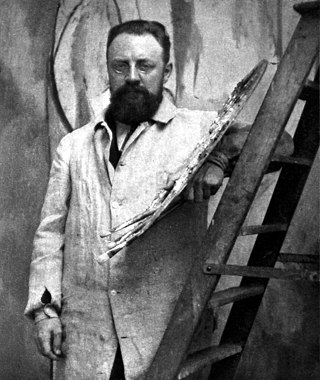
Henri Émile Benoît Matisse was a French visual artist, known for both his use of colour and his fluid and original draughtsmanship. He was a draughtsman, printmaker, and sculptor, but is known primarily as a painter. Matisse is commonly regarded, along with Pablo Picasso, as one of the artists who best helped to define the revolutionary developments in the visual arts throughout the opening decades of the twentieth century, responsible for significant developments in painting and sculpture.

André Derain was a French artist, painter, sculptor and co-founder of Fauvism with Henri Matisse.
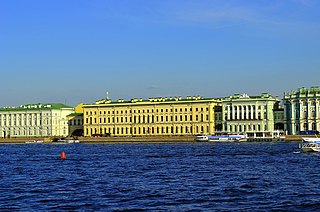
The State Hermitage Museum is a museum of art and culture in Saint Petersburg, Russia. It was founded in 1764 when Empress Catherine the Great acquired a collection of paintings from the Berlin merchant Johann Ernst Gotzkowsky. The museum celebrates the anniversary of its founding each year on 7 December, Saint Catherine's Day. It has been open to the public since 1852. The Art Newspaper ranked the museum 10th in their list of the most visited art museums, with 2,812,913 visitors in 2022.

Picasso's African Period, which lasted from 1906 to 1909, was the period when Pablo Picasso painted in a style which was strongly influenced by African sculpture, particularly traditional African masks and art of ancient Egypt, in addition to non-African influences including Iberian sculpture, and the art of Paul Cézanne and El Greco. This proto-Cubist period following Picasso's Blue Period and Rose Period has also been called the Negro Period, or Black Period. Picasso collected and drew inspiration from African art during this period, but also for many years after it.
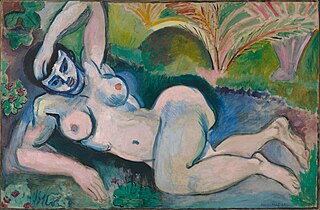
Blue Nude (Souvenir of Biskra) (French: "Nu bleu, Souvenir de Biskra"), an early 1907 oil painting on canvas by Henri Matisse, is located at the Baltimore Museum of Art as part of the Cone Collection.

Dance (La Danse) is a painting made by Henri Matisse in 1910, at the request of Russian businessman and art collector Sergei Shchukin, who bequeathed the large decorative panel to the Hermitage Museum in Saint Petersburg, Russia. The composition of dancing figures is commonly recognized as "a key point of (Matisse's) career and in the development of modern painting". A preliminary version of the work, sketched by Matisse in 1909 as a study for the work, resides at MoMA in New York City, where it has been labeled Dance (I).

The Young Sailor II is a painting by Henri Matisse from 1906. It is in the collection of the Metropolitan Museum of Art, New York.

The Conversation, a painting by Henri Matisse dating from 1908 to 1912, depicts the artist and his wife facing each other before a background of intense blue. It is in the collection of the Hermitage Museum in Saint Petersburg, Russia.
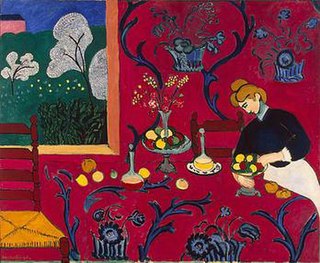
The Dessert: Harmony in Red is a painting by French artist Henri Matisse, from 1908. It is considered by some critics to be Matisse's masterpiece. This Fauvist painting follows the example set by Impressionism with the overall lack of a central focal point.

The Painter and His Model is a work by Henri Matisse painted late 1916, early 1917. It is currently in the collection of the Musée National d'Art Moderne, Centre Georges Pompidou, Paris. In this work Matisse depicted himself in his studio on the fourth floor of 19 Quai Saint-Michel, at work on his painting Laurette in a Green Robe (1916).
Robe violette et Anémones is a 1937 painting by Henri Matisse featuring a woman wearing a purple robe sitting next to a vase of anemones.
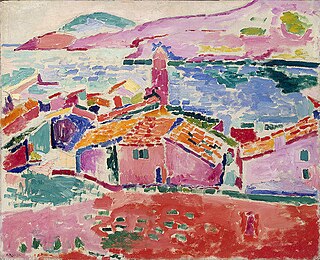
Les toits de Collioure is a 1905 oil-on-canvas painting by Henri Matisse. It is an example of the style that Matisse employed during his early period of Fauvism. The painting has been in the collection of The Hermitage, St. Petersburg, Russia since 1948. It was originally part of the Sergei Shchukin collection, and then was at the State Museum of New Western Art in Moscow.
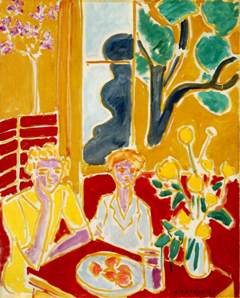
Deux fillettes, fond jaune et rouge (1947), oil on canvas, 61 x 49.8 cm is a painting by Henri Matisse in the collection of the Barnes Foundation, Merion, Pennsylvania.

Window at Tangier; also referred to as La Fenêtre à Tanger, Paysage vu d'une fenêtre, and Landscape viewed from a window, Tangiers, is a painting by Henri Matisse, executed in 1912. It is held at the Pushkin Museum of Fine Arts, Moscow.

Fauvism is the style of les Fauves, a group of early 20th-century modern artists whose works emphasized painterly qualities and strong colour over the representational or realistic values retained by Impressionism. While Fauvism as a style began around 1904 and continued beyond 1910, the movement as such lasted only a few years, 1905–1908, and had three exhibitions. The leaders of the movement were André Derain and Henri Matisse.

Music is a wall-size painting made by Henri Matisse in 1910. The painting was commissioned by Sergei Shchukin, who hung it with Matisse's 1910 Dance on the staircase of his Moscow mansion. Matisse made the painting without any preparatory sketches, and thus the painting bears many traces of modifications. One can virtually trace the steps Matisse took to find the intended effect. As in Dance, the aim was to show man's attainment of a state of completeness by immersion in creativity.

Sergei Ivanovich Shchukin was a Russian businessman who became an art collector, mainly of French Impressionist and Post-Impressionist art.

Goldfish is an oil-on-canvas still life painting by French visual artist Henri Matisse. Painted in 1912, Goldfish was part of a series that Matisse produced between the spring and early summer of 1912.
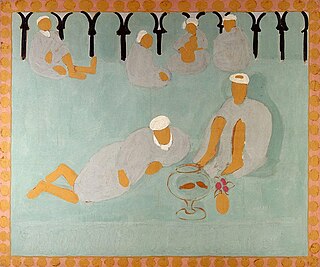
Arab Coffeehouse, is an oil-on-canvas painting by French visual artist Henri Matisse. Produced in 1913, Arab Coffeehouse was part of a series of goldfish paintings that Matisse produced in the 1910s and 1920s.


















